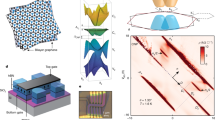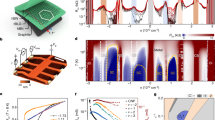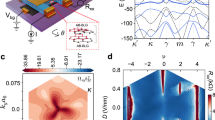Abstract
Magic-angle twisted bilayer graphene (tBLG) displays a variety of symmetry-broken phases, correlated Chern insulators, orbital magnetism and superconductivity1,2,3,4,5,6,7,8. In particular, the anomalous Hall effect has been observed when the bands are filled with an odd number of electrons per moiré unit cell5,6,9, indicating the emergence of a zero-field orbital magnetic state with spontaneously broken time-reversal symmetry10,11,12. Here we present measurements of two tBLG devices with twist angles slightly away from the magic angle and report the observation of the anomalous Hall effect at half filling of both the electron and hole moiré bands. We suggest that two factors—the increased band dispersion away from the magic angle, and substrate potentials from the encapsulating boron nitride—probably play critical roles in stabilizing a valley-polarized ground state at half filling. Our findings further expand the rich correlated phase diagram of tBLG, and indicate the need to develop a more complete understanding of its manifold of closely competing symmetry-breaking orders.
This is a preview of subscription content, access via your institution
Access options
Access Nature and 54 other Nature Portfolio journals
Get Nature+, our best-value online-access subscription
$29.99 / 30 days
cancel any time
Subscribe to this journal
Receive 12 print issues and online access
$209.00 per year
only $17.42 per issue
Buy this article
- Purchase on Springer Link
- Instant access to full article PDF
Prices may be subject to local taxes which are calculated during checkout




Similar content being viewed by others
Data availability
Data that support the plots within this paper and other findings of this study are available from the corresponding author upon reasonable request. Source data are provided with this paper.
References
Cao, Y. et al. Correlated insulator behaviour at half-filling in magic-angle graphene superlattices. Nature 556, 80–84 (2018).
Cao, Y. et al. Unconventional superconductivity in magic-angle graphene superlattices. Nature 556, 43–50 (2018).
Yankowitz, M. et al. Tuning superconductivity in twisted bilayer graphene. Science 363, 1059–1064 (2019).
Lu, X. et al. Superconductors, orbital magnets and correlated states in magic angle bilayer graphene. Nature 574, 653–657 (2019).
Sharpe, A. L. et al. Emergent ferromagnetism near three-quarters filling in twisted bilayer graphene. Science 365, 605–608 (2019).
Serlin, M. et al. Intrinsic quantized anomalous Hall effect in a moiré heterostructure. Science 367, 900–903 (2020).
Balents, L., Dean, C. R., Efetov, D. K. & Young, A. F. Superconductivity and strong correlations in moiré flat bands. Nat. Phys. 16, 725–733 (2020).
Andrei, E. Y. & MacDonald, A. H. Graphene bilayers with a twist. Nat. Mater. 19, 1265–1275 (2020).
Stepanov, P. et al. Competing zero-field Chern insulators in superconducting twisted bilayer graphene. Phys. Rev. Lett. 127, 197701 (2021).
Zhang, Y.-A., Mao, D., Cao, Y., Jarillo-Herrero, P. & Senthil, T. Nearly flat Chern bands in moiré superlattices. Phys. Rev. B 99, 075127 (2019).
Zhang, Y.-H., Mao, D. & Senthil, T. Twisted bilayer graphene aligned with hexagonal boron nitride: anomalous Hall effect and a lattice model. Phys. Rev. Res. 1, 033126 (2019).
Bultinck, N., Chatterjee, S. & Zaletel, M. P. Mechanism for anomalous Hall ferromagnetism in twisted bilayer graphene. Phys. Rev. Lett. 124, 166601 (2020).
Bistritzer, R. & MacDonald, A. H. Moiré bands in twisted double-layer graphene. Proc. Natl Acad. Sci. USA 108, 12233–12237 (2011).
Bultinck, N. et al. Ground state and hidden symmetry of magic-angle graphene at even integer filling. Phys. Rev. X 10, 031034 (2020).
Zhang, Y., Jiang, K., Wang, Z. & Zhang, F. Correlated insulating phases of twisted bilayer graphene at commensurate filling fractions: a Hartree–Fock study. Phys. Rev. B 102, 035136 (2020).
Liu, J. & Dai, X. Theories for the correlated insulating states and quantum anomalous Hall effect phenomena in twisted bilayer graphene. Phys. Rev. B 103, 035427 (2021).
Po, H. C., Zou, L., Vishwanath, A. & Senthil, T. Origin of Mott insulating behavior and superconductivity in twisted bilayer graphene. Phys. Rev. X 8, 031089 (2018).
Lian, B. et al. Twisted bilayer graphene. IV. Exact insulator ground states and phase diagram. Phys. Rev. B 103, 205414 (2021).
Kwan, Y. H. et al. Kekulé spiral order at all nonzero integer fillings in twisted bilayer graphene. Phys. Rev. X 11, 041063 (2021).
Wagner, G., Kwan, Y. H., Bultinck, N., Simon, S. H. & Parameswaran, S. A. Global phase diagram of the normal state of twisted bilayer graphene. Phys. Rev. Lett. 128, 156401 (2022).
Lin, J.-X. et al. Spin-orbit-driven ferromagnetism at half moiré filling in magic-angle twisted bilayer graphene. Science 375, 437–441 (2022).
Wong, D. et al. Cascade of electronic transitions in magic-angle twisted bilayer graphene. Nature 582, 198–202 (2020).
Zondiner, U. et al. Cascade of phase transitions and dirac revivals in magic-angle graphene. Nature 582, 203–208 (2020).
Polshyn, H. et al. Electrical switching of magnetic order in an orbital Chern insulator. Nature 588, 66–70 (2020).
Grover, S. et al. Chern mosaic and Berry-curvature magnetism in magic-angle graphene. Nat. Phys. (2022). https://doi.org/10.1038/s41567-022-01635-7
Zhu, J., Su, J.-J. & MacDonald, A. H. Voltage-controlled magnetic reversal in orbital Chern insulators. Phys. Rev. Lett. 125, 227702 (2020).
Tschirhart, C. L. et al. Imaging orbital ferromagnetism in a moiré Chern insulator. Science 372, 1323–1327 (2021).
Sharpe, A. L. et al. Evidence of orbital ferromagnetism in twisted bilayer graphene aligned to hexagonal boron nitride. Nano Lett. 21, 4299–4303 (2021).
Khalaf, E., Ledwith, P. & Vishwanath, A. Symmetry constraints on superconductivity in twisted bilayer graphene: fractional vortices, 4e condensates or non-unitary pairing. Phys. Rev. B 105, 224508 (2020).
Diez-Merida, J. et al. Magnetic Josephson junctions and superconducting diodes in magic angle twisted bilayer graphene. Preprint at https://arxiv.org/abs/2110.01067 (2021).
Stepanov, P. et al. Untying the insulating and superconducting orders in magic-angle graphene. Nature 583, 375–378 (2020).
Codecido, E. et al. Correlated insulating and superconducting states in twisted bilayer graphene below the magic angle. Sci. Adv. 5, eaaw9770 (2019).
Saito, Y., Ge, J., Watanabe, K., Taniguchi, T. & Young, A. F. Independent superconductors and correlated insulators in twisted bilayer graphene. Nat. Phys. 16, 926–930 (2020).
Cao, Y. et al. Nematicity and competing orders in superconducting magic-angle graphene. Science 372, 264–271 (2021).
Wang, L. et al. One-dimensional electrical contact to a two-dimensional material. Science 342, 614–617 (2013).
Hunt, B. et al. Massive Dirac fermions and Hofstadter butterfly in a van der Waals heterostructure. Science 340, 1427–1430 (2013).
Shi, J., Zhu, J. & MacDonald, A. H. Moiré commensurability and the quantum anomalous Hall effect in twisted bilayer graphene on hexagonal boron nitride. Phys. Rev. B 103, 075122 (2021).
Lin, X., Su, K. & Ni, J. Misalignment instability in magic-angle twisted bilayer graphene on hexagonal boron nitride. 2D Mater. 8, 025025 (2021).
Mao, D. & Senthil, T. Quasiperiodicity, band topology and moiré graphene. Phys. Rev. B 103, 115110 (2021).
Acknowledgements
We thank Y. Zhang, N. Bultinck and Z.-D. Song for helpful discussions. This work was supported as part of Programmable Quantum Materials, an Energy Frontier Research Center funded by the US Department of Energy (DOE), Office of Science, Basic Energy Sciences (BES), under award no. DE-SC0019443 to M.Y. and J.-H.C.; the Army Research Office under grant no. W911NF-20-1-0211 to M.Y.; and the Gordon and Betty Moore Foundation’s EPiQS Initiative, grant no. GBMF6759 to J.-H.C. J.-H.C. also acknowledges support from the David and Lucile Packard Foundation. M.Y. and J.-H.C. acknowledge support from the State of Washington-funded Clean Energy Institute. This research acknowledges the usage of a dilution refrigerator system that was provided by NSF DMR-1725221, and of the millikelvin optoelectronic quantum material laboratory supported by the M.J. Murdock Charitable Trust. K.W. and T.T. acknowledge support from the Elemental Strategy Initiative conducted by the MEXT, Japan (grant no. JPMXP0112101001) and JSPS KAKENHI (grants nos. 19H05790, 20H00354 and 21H05233).
Author information
Authors and Affiliations
Contributions
C.-C.T. and X.M. fabricated the devices. C.-C.T., X.M. and Z.L. performed the measurements. K.W. and T.T. provided the bulk BN crystals. C.-C.T., X.M., Z.L., J.-H.C. and M.Y. analysed the data and wrote the paper.
Corresponding author
Ethics declarations
Competing interests
The authors declare no competing interests.
Peer review
Peer review information
Nature Physics thanks the anonymous reviewers for their contribution to the peer review of this work
Additional information
Publisher’s note Springer Nature remains neutral with regard to jurisdictional claims in published maps and institutional affiliations.
Extended data
Extended Data Fig. 1 Optical micrographs of the devices.
a, Device D1. b, Device D2. The twist angle measured between neighboring pairs of contacts is also shown. The scale bars are 5 μm.
Extended Data Fig. 2 Electric-field-reversal of the magnetic state in Device D1.
a,b, ρxy acquired by sweeping ν from small to large values (a), and from large to small values (b), at fixed B and T = 20 mK. c,d, The same measurements performed at T = 1.5 K. At both temperatures, we observe hysteresis at low magnetic fields depending on the direction the doping is swept.
Extended Data Fig. 3 Possible alignment of tBLG and BN.
Optical micrographs of the completed heterostructures of a, Device D1 and b, Device D2 prior to device fabrication. The top and bottom BN flakes are outlined in green and blue dashed lines, respectively. Angular alignment between the tBLG and BN is estimated by comparing the orientation of the straight crystallographic edges of each. A representative graphene edge is denoted by the white dashed line, and the angular offset with a selected BN edge is denoted next to the corresponding black dashed lines. A few selected BN corners with modulo-30∘ angles are denoted by the solid black lines, establishing that these are likely zigzag or armchair edges. In both devices, the top BN and tBLG appear to have a 29–30∘ angular offset. This indicates a high likelihood of few-degree or smaller alignment of the graphene and top BN crystals, although there is inherent uncertainty in identifying perfect crystalline edges of graphene. The scale bars are 5 μm.
Extended Data Fig. 4 Thermal activation of the CNP in Device D1.
a, Resistivity of Device D1 at the CNP (ν = 0) measured as a function of temperature, exhibiting insulating behavior below approximately 25 K. The red curve is measured in a VTI down to 1.5 K, and the blue curve is measured in a dilution fridge down to 20 mk. b, The same data shown on an Arrhenius plot. The CNP exhibits a small region of (approximately) activated behavior. We extract the band gap, Δ = 2.2 meV, from the slope of the linear fit (red dashed line) using \(\rho \,\propto \,e^{\frac{\Delta }{2kT}}\), where k is the Boltzmann constant.
Extended Data Fig. 5 Transport measurements from additional contact pairs in Device D2.
a–c, ρxx and d–f, ρxy Landau fan diagrams measured between different pairs of contacts corresponding to the contact labeling scheme in Extended Data Fig. 1b. The strength of the coexisting trivial insulating state at ν = − 2 varies substantially depending on the contact pair. g–i, Measurements of the AHE near ν = − 2 acquired using the same contacts as the associated ρxy fans shown in (d–f). The data are acquired at the same gate voltage, which corresponds to a slightly different value of ν due to the twist angle disorder in the sample. The AHE is only observed in contact pairs A–F, despite the overall similarities of the Landau fans. For contacts B–G in particular, there is a large offset from ρxy = 0 due to mixing with ρxx. All measurements are acquired at T = 100 mK.
Extended Data Fig. 6 Landau fan diagrams from additional contact pairs in Device D1.
a–c, Landau fan diagrams of ρxx and d–f, ρxy measured between different pairs of contacts corresponding to the contact labeling scheme in Extended Data Fig. 1a. All measurements are acquired at T = 20 mK.
Extended Data Fig. 7 AHE near ν = + 2 measured in additional contact pairs in Device D1.
a,b, ρxx and c,f, ρxy acquired with the contacts denoted above each plot, following the labeling scheme shown in Extended Data Fig. 1a. The data are all acquired at the same gate voltage, which corresponds to a slightly different value of ν due to the twist angle disorder in the sample. All measurements are acquired at T = 20 mK.
Extended Data Fig. 8 AHE versus doping in Device D2.
ρxy measured as B is swept back and forth around at selected values of ν around ν = − 2 in Device D2. The measurements are acquired at T = 100 mK.
Source data
Source Data Fig. 1
Source data for Fig. 1, all panels.
Source Data Fig. 2
Source data for Fig. 2, all panels.
Source Data Fig. 3
Source data for Fig. 3, panels a–b, d–g.
Source Data Extended Data Fig. 2
Source data for ED Fig. 2, all panels.
Source Data Extended Data Fig. 4
Source data for ED Fig. 4, all panels.
Source Data Extended Data Fig. 5
Source data for ED Fig. 5, all panels.
Source Data Extended Data Fig. 6
Source data for ED Fig. 6, all panels.
Source Data Extended Data Fig. 7
Source data for ED Fig. 7, all panels.
Source Data Extended Data Fig. 8
Source data for ED Fig. 8.
Rights and permissions
About this article
Cite this article
Tseng, CC., Ma, X., Liu, Z. et al. Anomalous Hall effect at half filling in twisted bilayer graphene. Nat. Phys. 18, 1038–1042 (2022). https://doi.org/10.1038/s41567-022-01697-7
Received:
Accepted:
Published:
Issue Date:
DOI: https://doi.org/10.1038/s41567-022-01697-7
This article is cited by
-
Symmetry-broken Josephson junctions and superconducting diodes in magic-angle twisted bilayer graphene
Nature Communications (2023)
-
Spin-orbit coupling-enhanced valley ordering of malleable bands in twisted bilayer graphene on WSe2
Nature Communications (2023)



